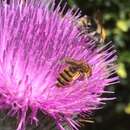fi
nimet breadcrumb-navigoinnissa


Halictus scabiosae is common in Europe. Like other species of Halictus, nests are underground burrows opening onto an earthen comb of cells. The social biology of the species is complex, not completely known, and likely flexible. In a population in southern France, females mated in autumn, then overwintered with other females. In spring, these co-foundresses began nesting, with one established as the dominant egg-layer (queen) staying at the nest to guard, and the others as subordinate helpers foraging for the queens’ offspring. These subordinates are eventually chased away, and may usurp the nest of other bees to establish themselves as reproductives. The daughters of the primary reproductive emerge and work as subordinate helpers to their mother, making the colony eusocial. These summer females are smaller, and few males are produced at this time, as the females are non-reproductive workers. Later in the autumn, reproductive females and males are produced. Nests are frequently found in aggregations (Reviewed Ulrich et al. 2009). However, Batra (1966) found a different pattern in seven nests from Geneva, Switzerland. Workers were not smaller than queens, foragers were often mated, and some nests contained more than one individual with active ovaries. This suggests that H. scabiosae might be communal, with multiple reproducing females.
Ulrich et al. (2010) combined nest collections with microsatellite genetic related analysis to show that in a population in Lausanne, Switzerland, there were indeed different social organizations present. About half of 60 nests sampled contained the offspring of only one female, the queen, and in at least three cases multiple females were reproducing. They also found that 53% of their study popultaion’s, and 42-73% of other nearby populations’, nests failed after initiation but before the emergence of new brood. 31% of nests were founded by more than one female. Ulrich et al. (2010) also noted the presence of drifting later in the season: females from relatively productive nests moving to other, often unoccupied, nests, sometimes with their sisters. The authors hypothesize that because these productive nests probably already have sufficient female reproductives to overwinter, the drifting females are in effect dispersing, and will be co-foundresses in their new nest the following spring.